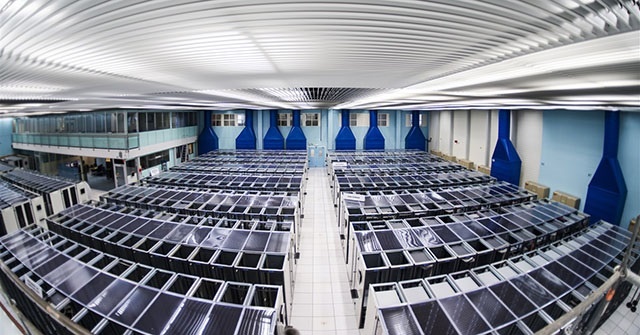The Mohamed V University in Rabat (Morocco), in collaboration with the IFIC, prepares the launch of a GRID computing infrastructure which supports the ATLAS experiment of the LHC. The new centre will store and process data of the Large Hadron Collider (LHC.) It is a scientific cooperation project for the development that is funded by CSIC. It aims at bridging the gap of this kind of infrastructures in Africa.
The world map which shows the centres that store and process the huge amount of data that the Large Hadron Collider (LHC) produces has a great emptiness: Africa. There is only one centre that contributes to the LHC computing network in Cape Town (South Africa.) The challenge is to place another centre in the map. In order to do so, the Mohamed V University of Rabat (Morocco) is working in collaboration with the Institute for Corpuscular Physics (IFIC, CSIC-UV) thanks to one of the scientific cooperation projects for the development of the CSIC. The aim of the project is the launch of a GRID computing infrastructure which supports the ATLAS experiment of the LHC as well as other experiments in High Energy Physics.
LHC produces more than 50 petabytes (PB) of data per year. This is the equivalent to 15 million high definition films. Google searches represent almost 100 PB per year and Facebook contents represent about 180 PB per year. The LHC is now in its second operation phase or Run 2. In 2016 it obtained twice the amount of data than expected and as of 2025, when it will be submitted to a major renovation, it will multiply by ten its brightness which is a way of measuring the amount of collisions that will take place in its experiments. This entails much more data to store and process.
The challenges of the computing network called GRID which distributes, stores and processes these data are also huge. That is the reason why there is a nodular structure to share the resources which starts from the called Tier 0 (located in the CERN and in Budapest,) goes over the 13 Tier 1 and arrives at 160 Tier 2. The Institute for Corpuscular Physics (IFIC, CSIC-UV) hosts one of those Tier 2 devoted to the ATLAS experiment, one of the detectors of the LHC where the institute takes part. This institute discovered the Higgs boson in 2012.
The IFIC brings its experience as a reference centre for the computing LHC in a collaboration with the Mohamed V University of Rabat (Morocco) whose aim is the launch and the use of a GRID computing infrastructure in this country. This collaboration is supported by one of the scientific cooperation projects I-COOP+ for the development funded by CSIC for the period 2017-2018. The objective of the project is the training of the Moroccan research staff in the facilities of the IFIC in the Science Park of the Universitat de València.
The researchers and doctoral students of the Mohamed V University in Rabat which visit the IFIC will work during a month with the group devoted to GRID of the ATLAS experiment. Furthermore, thanks to the collaboration stablished one decade ago with Farida Fassi Imlahi, who did her doctoral programme and a part of her scientific career in the IFIC and who is now professor in the Moroccan University, other joint research lines will be developed. One of these lines will be the study of the differences between top quark, the most massive elementary particle and its antiparticle in the highest energy collisions of the LHC.
The research groups from Rabat and IFIC have played an important role in the development and application of the new techniques to select and rebuild boosted top quarks. This is one of the most sensitive tools to detect new physics beyond the Standard Model of particle physics, which is the theory that describes the elementary particles and its interactions. This project aims at encouraging these analysis and making easier the access of the Moroccan students to the ATLAS data.
Apart from the Mohamed V University in Rabat, other Moroccan institutions take part in the ATLAS experiment: University of Hassan II (Casablanca), Mohamed I University (Oujda), Cadi Ayyad University (Marrakech) and CNESTEN, a research centre with headquarters in Rabat. This institutions are grouped in the RUPHE (Moroccan cluster for high energy physics.) The National Centre for Scientific and Technical Research of Morocco (CNRST) works since 2005 on computing technologies distributed through cooperation projects with Italy and Spain as well as with the Institute for Corpuscular Physics.
Within this collaboration, it is studied the use of the computing infrastructure GRID to support other research lines that are emerging in Morocco such as medical physics or neutrino telescopes ANTARES and KM3NeT. In fact, Morocco contributes to build a part of the KM3NeT which will be the biggest neutrino telescope submerged in the Mediterranean. IFIC leads initiatives in both fields. This is the reason why this cooperation project will contribute to strengthen the scientific collaboration between the Valencian research centre and the Moroccan cluster.
More information can be found in:


